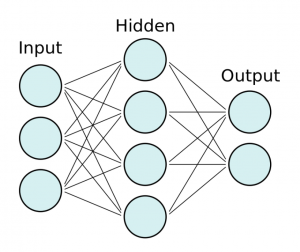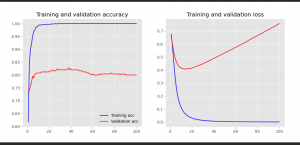– Neural network model

> We have to multiply each input node by a weight w and add a bias b.
> It is generally common to use a rectified linear unit (ReLU) for hidden layers, a sigmoid function for the output layer in a binary classification problem, or a softmax function for the output layer of multi-class classification problems.
### Keras
– Keras is a deep learning and neural networks API by Francois Chollet
$ pip3 install keras
kerasを使うにはbackgroundにtensorflowが動いていないといけないので、amazon linux2にtensorflowをインストールします。
$ pip3 install tensorflow
$ python3 -c “import tensorflow as tf; print(tf.reduce_sum(tf.random.normal([1000, 1000])))”
tf.Tensor(-784.01, shape=(), dtype=float32)
上手くインストールできたようです。
from keras.models import Sequential from keras import layers // 省略 input_dim = X_train.shape[1] model = Sequential() model.add(layers.Dense(10, input_dim=input_dim, activation='relu')) model.add(layers.Dense(1, activation='sigmoid'))
model.add(layers.Dense(10, input_dim=input_dim, activation='relu')) model.add(layers.Dense(1, activation='sigmoid')) model.compile(loss='binary_crossentropy', optimizer='adam', metrics=['accuracy']) print(model.summary())
$ python3 split.py
_________________________________________________________________
Layer (type) Output Shape Param #
=================================================================
dense (Dense) (None, 10) 17150
_________________________________________________________________
dense_1 (Dense) (None, 1) 11
=================================================================
Total params: 17,161
Trainable params: 17,161
Non-trainable params: 0
_________________________________________________________________
None
### batch size
history = model.fit(X_train, y_train, epochs=100, verbose=False, validation_data=(X_test, y_test) batch_size=10)
### evaluate accuracy
loss, accuracy = model.evaluate(X_train, y_train, verbose=False)
print("Training Accuracy: {:.4f}".format(accuracy))
loss, accuracy = model.evaluate(X_test, y_test, verbose=False)
print("Training Accuracy: {:.4f}".format(accuracy))
$ python3 split.py
Training Accuracy: 1.0000
Training Accuracy: 0.8040
### matplotlib
$ pip3 install matplotlib
import matplotlib.pyplot as plt
// 省略
def plot_history(history):
acc = history.history['accuracy']
val_acc = history.history['val_accuracy']
loss = history.history['loss']
val_loss = history.history['val_loss']
x = range(1, len(acc) + 1)
plt.figure(figsize=(12, 5))
plt.subplot(1, 2, 1)
plt.plot(x, acc, 'b', label='Training acc')
plt.plot(x, val_acc, 'r', label='Validation acc')
plt.title('Training and validation accuracy')
plt.legend()
plt.subplot(1, 2, 2)
plt.plot(x, loss, 'b', label='Training loss')
plt.plot(x, val_loss, 'r', label='Validation loss')
plt.title('Training and validation loss')
plt.savefig("img.png")
plot_history(history)

おおお、なんか凄え
